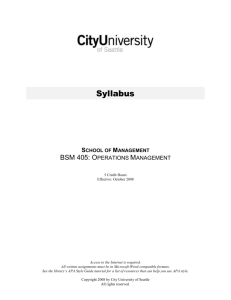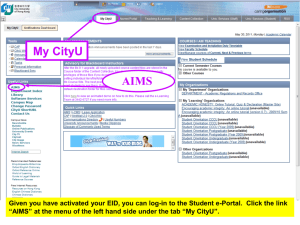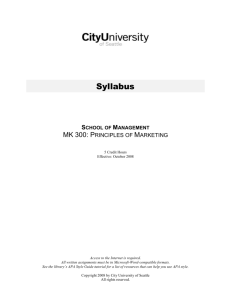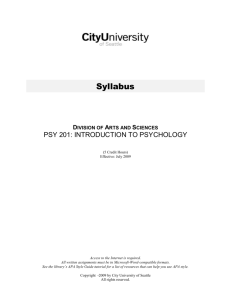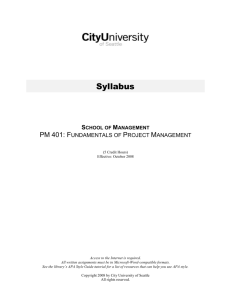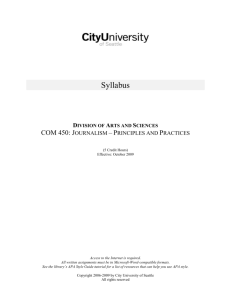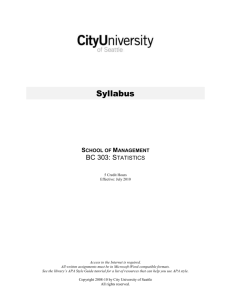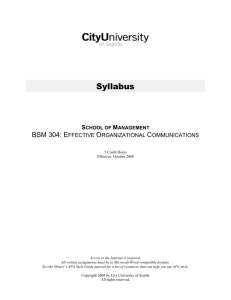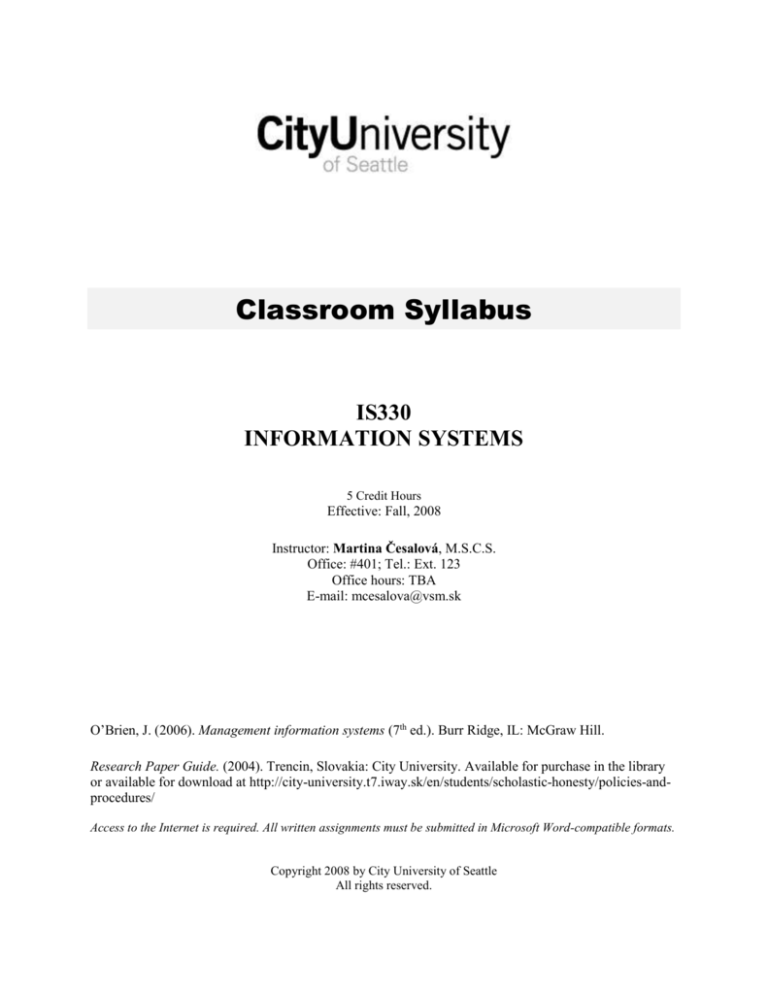
Classroom Syllabus
IS330
INFORMATION SYSTEMS
5 Credit Hours
Effective: Fall, 2008
Instructor: Martina Česalová, M.S.C.S.
Office: #401; Tel.: Ext. 123
Office hours: TBA
E-mail: mcesalova@vsm.sk
O’Brien, J. (2006). Management information systems (7th ed.). Burr Ridge, IL: McGraw Hill.
Research Paper Guide. (2004). Trencin, Slovakia: City University. Available for purchase in the library
or available for download at http://city-university.t7.iway.sk/en/students/scholastic-honesty/policies-andprocedures/
Access to the Internet is required. All written assignments must be submitted in Microsoft Word-compatible formats.
Copyright 2008 by City University of Seattle
All rights reserved.
IS330
INFORMATION SYSTEMS
FACULTY
Faculty Name: Martina Česalová, M.S.C.S.
Contact Information: mcesalova@vsm.sk
SCHOLASTIC HONESTY
Scholastic Honesty City University of Seattle expects each student to do his/her own work. The
University has "zero tolerance" for cheating, plagiarism, unauthorized collaboration on assignments and
papers, using "notes" during exams, submitting someone else's work as one's own, submitting work
previously submitted for another course, or facilitating acts of academic dishonesty by others. The
penalties are severe! A first offense can result in a zero grade for the course and suspension for one
quarter; a second offense can result in a zero grade for the course and suspension for two or more
quarters; a third offense can result in expulsion from the University. The Policy and Procedures may be
found at http://city-university.t7.iway.sk/en/students/scholastic-honesty/policies-and-procedures/
In addition to providing your work to the instructor for grading, you must also submit an electronic copy
for the City University of Seattle archives (unless the work is specifically exempted by the instructor).
You will not receive a grade for particular work until and unless you submit this electronic copy. The
procedure for submitting work to the archives is to upload it via the website http://cityuniversity.t7.iway.sk/en/students/on-line-center/uploader/uploader.html . Files should include the cover
page of the work with the student name, instructor name, course name and number, and date. File names
should indicate the type of assignment, such as “researchpaper.doc”, “casestudy.doc” or “ thesis.doc”
(student name should not be a part of the file name because the system adds it). All files received into the
archives are submitted to www.TurnItIn.com for plagiarism checking.
COURSE DESCRIPTION
This course will cover information systems taxonomies and general applications such as CRM, SCM,
eCommerce, ERP, business intelligence, knowledge management, finance and accounting, personal
productivity, computer supported cooperative work (groupware), and global systems. Future trends and
directions of information systems will conclude this course.
CITYU LEARNING GOALS
The content of this course addresses the following CityU Learning Goals:
Professional Competency and Professional Identity
Strong Communication and Interpersonal Skills
Critical Thinking
IS 330
Page 2
Eff: 10/08
PROGRAM CONTEXT
The program provides the skills, insights and perspectives required for IS professionals desiring to take an
active role in the future of technology as a key enabler to the effectiveness of business organizations and a
truly global society. This course provide focus on managing in a digital world though valuing,
managing, securing, enhancing, building, and ethical comprehension of Information Systems. Students
will emerge with the experience required to influence technology-enabled growth in whatever industry or
pursuit they choose.
The content of this course aligns with the following program outcomes:
Evaluate emerging technologies of interest in a business or government environment
Identify and analyze IT opportunities in a business environment.
COURSE OUTCOMES
Upon completion of this course, learners will successfully demonstrate the following outcomes:
Evaluate current level of understanding and competence with Information Systems as outlined in
the course.
Illustrate the ability to communicate in an online environment via Blackboard (Bb) and create a
sense of a learning community.
Integrate the informational knowledge with personal career.
Demonstrate the ability to use critical thinking skills to evaluate an area of Information Systems
that is directly related to current career
Appraise the level of competence and synthesis of the personal application of Information
Systems.
CORE CONCEPTS, KNOWLEDGE AND SKILLS
System characteristics;
Types of information systems available in business;
Key ethical challenges of IT use in the organization;
Value of IS to the Value Chain;
Transaction processing cycle;
Key features of a DSS;
Benefits and limitations of electronic communication tools;
Components of an E-commerce process architecture;
Major components in E-business planning;
System development lifecycle;
Role of feasibility studies in the SDLC;
Role of the Functional Requirements Analysis;
Forms of computer crime in E-business;
IT-based ethical guidelines;
Security measures used in IT;
Challenges to managing the IS function;
Database structures;
Relationship between data planning and database design.
IS 330
Page 3
Eff: 10/08
COURSE RESOURCES
Required and recommended resources to complete coursework and assignments are listed on the
My.CityU portal at Library>Resources by Course.
OVERVIEW OF COURSE GRADING
The grade you receive for the course will be derived using City University of Seattle’s decimal grading
system, based on the following:
Overview of Required Assignments
Information Technologies Initial Pre
self-analysis
Career-focused Case Analysis
Information Systems Design Project
Information Systems Design Project
Presentation
Midterm Exam
Final Exam including Information
Systems Final post self-analysis
TOTAL
% of Final Grade
10%
15%
28%
12%
15%
20%
100%
SPECIFICS OF COURSE ASSIGNMENTS
Information Technologies Initial Pre self-analysis
Write a one page double –spaced assessment of your current state of understanding Information
Technologies as it applies to your field of study. Review the recommended course schedule or the text
book for the topics covered in this class. Include one outside resource. Cite this resource in the body of
your text and list it as a reference, using the APA format. Following the given instructions, design a
simple web page with the pre-self analysis and publish it on the Internet.
Assessment Rubric: Information Systems Initial Pre self-analysis
Undergraduate Percentage Scale:
Undergraduate Scaled Score:
% of
Grade
Articulation of course
concepts
Completeness of self assessment
Correct use of APA
reference
(one in-body citation
0.00 - 58.74%
0.0 - 0.6
Below Standard
58.75 - 76.24%
0.7 - 2.1
Approaching
Standard
IS 330
Eff: 10/08
30%
40%
15%
Page 4
76.25 - 93.74%
2.2 - 3.5
At Standard
93.75 - 100%
3.6 - 4.0
Exceeds
Standard
and reference page)
Proper grammar,
spelling, and
punctuation
TOTAL
15%
100%
Career-focused Case Analysis
Chose a case from the book, library, or real-life a “case” to analyze that you are dealing with or might
deal with in the future in your career. Focus on any issue surrounding any aspect of Information Systems
as it is covered in your textbook. A case analysis is designed to help you sharpen your analytical skills.
The strongest way to analyze a case is to apply a variation of the scientific method. This method of
analysis is simply a logical approach that usually includes the seven steps outlined below.
Step 1: Problem Definition
A case seldom involves one clear-cut problem. Your task is to:
determine the symptoms which require immediate attention;
identify the fundamental issues and causal factors giving rise to these symptoms.
It is important to separate the immediate problems from their more basic causes. For example, the
immediate problem may be a high rate of absenteeism, while the more fundamental issue may be a poor
motivational climate. How you define a problem determines how you go about solving it. A short-term
solution for absenteeism is likely to be different from solutions which attempt to deal with motivational
climate. Be sure to identify both the symptom and, more importantly, its underlying cause.
Step 2: Justification for Problem Definition
In this step you need to review the information you have about the problem. You may need to make some
inferences to fill in gaps. Clearly label what is inference and what is factual. Do not be afraid to assume,
but clearly state the assumptions you are making. You should make assumptions on the basis of your
knowledge of typical managerial practices, and they should be consistent with the facts about the case,
even though your facts may be somewhat limited. Managerial decisions are often based on limited
information. In fact, practicing managers find that many of their decisions have to be made quickly on the
basis of limited information.
Step 3: List Alternative Courses of Action
Be creative. Jot down ideas as they come to you. List as many ideas as you can without evaluating them
or censoring anything. You can always cross them out later. The point is to let your imagination take
over.
Step 4: Evaluate Alternatives
Look critically at the alternatives you came up with in Step 3. List advantages and disadvantages of each
alternative in terms of criteria that seem appropriate.
IS 330
Page 5
Eff: 10/08
Step 5: Review
Reread your notes and think. This may be a good time to let the case sit for a while. Get back to it later
when you have a chance to digest all the data.
Step 6: Draw Conclusions, Make Recommendations/Decisions
Select the alternative you would recommend and explain/justify your choice. Include specifics about the
implementation of your recommendation: who should do what, when, and how.
Step 7: Follow Up and Evaluate
Given the limitations of a classroom setting, you cannot implement your recommendation and evaluate its
actual impact. However, in this step you will describe how you would set up an evaluation procedure.
Suggest a timetable and methods for the evaluation process. State who should do the evaluating.
Source: Myers, T. & Myers, G. (1982). Managing by communication: An organizational approach. New York: McGraw-Hill Book.
Assessment Rubric: Career-focused Case Analysis
Undergraduate Percentage Scale:
Undergraduate Scaled Score:
% of
Grade
Case relationship to
course concepts
Completeness of
analysis via
advantages and
disadvantages
Originality of
conclusions
Proper grammar,
spelling, and
punctuation
APA referencing
Use of 3 minimum
outside resources
20%
TOTAL
100%
0.00 - 58.74%
0.0 - 0.6
Below Standard
58.75 - 76.24%
0.7 - 2.1
Approaching
Standard
76.25 - 93.74%
2.2 - 3.5
At Standard
93.75 - 100%
3.6 - 4.0
Exceeds
Standard
30%
20%
15%
15%
Information Systems Design Project
This assignment was designed to integrate the theoretical part of the course. You will be asked to design a
computer-based IS for a company /organization specified by some other student. Then, you will follow
the steps of SDLC (systems development life cycle) and describe what you have to acquire to implement
the new or improved system. You will be asked to submit and upload documentation of your project that
will incorporate detailed system development project plan /including SDLC steps, proposed type of
system conversion and technology prices/ and publish your plan in an online environment.
IS 330
Page 6
Eff: 10/08
Assessment Rubric: Information Systems Design Project
Undergraduate Percentage Scale:
Undergraduate Scaled Score:
% of
Grade
Clear thesis statement
Seamless flow of
personal insights for
integration
Logical development
and conclusion
Proper grammar,
spelling, and
punctuation
APA referencing
(minimum of 5 outside
sources, sited in-body
and appropriately
referenced)
TOTAL
0.00 - 58.74%
0.0 - 0.6
Below Standard
58.75 - 76.24%
0.7 - 2.1
Approaching
Standard
76.25 - 93.74%
2.2 - 3.5
At Standard
93.75 - 100%
3.6 - 4.0
Exceeds
Standard
20%
30%
20%
15%
15%
100%
Information Systems Design Project Presentation
Each student will present the Information Systems Design Project findings. The in-class presentation will
be delivered orally; supported by a PowerPoint slideshow. The presentation will be conducted as a formal
business presentation, as if the intended audience is the General Manager or CEO of an organization.
Information provided will include an explanation of the new system selection criteria and introduction of
the new system resources, including cross-functional systems.
Assessment Rubric: Information Systems Design Project Presentation
Undergraduate Percentage
Scale:
Undergraduate Scaled Score:
% of
Grade
Organization
Style
Use of
Communication
Aids
Depth of Content
0.00 – 68.74%
0.0 – 1.5
Below Standard
68.75 – 81.24%
1.6 – 2.5
Approaching
Standard
81.25 – 93.74%
2.6 – 3.5
At Standard
93.75 – 100%
3.6 – 4.0
Exceeds Standard
30
15
15
40
Examinations
You should be prepared to answer a variety of types of questions pertinent to the concepts covered in or
suggested by the course materials, assignments and activities. The final exam will include an essay
question on final post analysis assessment.
IS 330
Page 7
Eff: 10/08
Assessment Rubric: Essay Questions on Examinations
Undergraduate Percentage Scale:
Undergraduate Scaled Score:
% of
Grade
Application of course
concepts
Completeness of final
course synthesis
Direct demonstration
of personal
competence
Clear demonstration of
knowledge of key
issues
Proper grammar,
spelling, and
punctuation
TOTAL
0.00 - 58.74%
0.0 - 0.6
Below Standard
58.75 - 76.24%
0.7 - 2.1
Approaching
Standard
76.25 - 93.74%
2.2 - 3.5
At Standard
93.75 - 100%
3.6 - 4.0
Exceeds
Standard
25%
25%
20%
15%
15%
100%
UNIVERSITY POLICIES
You are responsible for understanding and adhering to all of City University of Seattle’s academic
policies. The most current versions of these policies can be found in the university catalog that is linked
from the CityU Web site.
Academic Integrity
Scholastic honesty in students requires the pursuit of scholarly activity that is free from fraud, deception
and unauthorized collaboration with other individuals. You are responsible for understanding CityU’s
policy on scholastic honesty and adhering to its standards in meeting all course requirements. A complete
copy of this policy can be found in the university catalog in the section titled Scholastic Honesty under
Student Rights & Responsibilities.
COURSE POLICIES
Attendance
Students taking courses in any format at the University are expected to be diligent in their studies and to
attend class regularly. Regular class attendance is important in achieving learning outcomes in the course
and may be a valid consideration in determining the final grade.
Participation and Student Behavior
Students who come to class will be expected to listen and to participate fully in classroom discussions of
the course material and in class assignments. Disruptions of the lecture or discussion of the material will
not be tolerated. Disruptions of the lecture and classroom discussion include:
Being late for class
Continuous talking, laughing
IS 330
Page 8
Eff: 10/08
Talking while instructor is lecturing or when other students are speaking and expressing their
ideas
Reading newspapers, magazines, journals, books, etc. not related to the course
Listening to music
Sleeping or resting
Wandering in and out of class without permission
Chatting, e-mailing or using the Internet for private purposes
Students who disrupt the class will be asked to leave the classroom and will be marked absent.
Late Assignments
Late assignments will NOT be accepted!
SUPPORT SERVICES
Disability Resources
If you are a student with a disability and you require an accommodation, please contact your instructor as
soon as possible. For additional information, please see the section in the university catalog titled Students
with Special Needs under Student Rights & Responsibilities.
Library Services
In order to help you succeed in this course, you have access to library services and resources 24 hours a
day, seven days a week. CityU librarians can help you formulate search strategies and locate materials
that are relevant to your coursework. For help, contact a CityU librarian through the Ask a Librarian
service. To find library resources, click on the Library link in the My.CityU portal.
SmartThinking
As a CityU student, you have access to 10 free hours of online tutoring, including writing support, from
certified tutors 24 hours a day, seven days a week. Contact CityU’s Student Support Center at
info@cityu.edu to request your user name and password.
IS 330
Page 9
Eff: 10/08
RECOMMENDED COURSE SCHEDULE
The schedule for course activities and assignments is below. If you find you are unable to complete the
assignments as scheduled, contact your instructor. Your instructor may elect to adjust the outline to meet
the unique needs of the class.
SESSION
TOPICS AND ASSIGNMENTS
READINGS
Foundations of Information Systems in Business
O’Brien Ch. 1
2
Computer Hardware
Computer Software
O’Brien Ch. 3, 4
3
Telecommunications and Networks
Data Resource Management
DUE: Information Technologies Initial Pre self-analysis
O’Brien Ch. 6, 5
4
Competing with IT
O’Brien Ch. 2
5
Electronic Commerce Systems
DUE: Midterm Examination
O’Brien Ch. 9
6
Electronic Business Systems
Enterprise Business Systems
O’Brien Ch. 7, 8
7
Decision Support Systems
Developing Business/IT Strategies
DUE: Career-focused Case Analysis
O’Brien Ch. 10, 11
8
Developing Business /IT Solution
Security and Ethical Challenges
O’Brien Ch. 12, 13
9
Enterprise and Global Management of Information Technology
DUE: Information Systems Design Project
DUE: Information Systems Design Project Presentation
O’Brien Ch. 14
10
DUE: Final Examination
1
IS 330
Page 10
Eff: 10/08
IS 330
Page 11
Eff: 10/08

